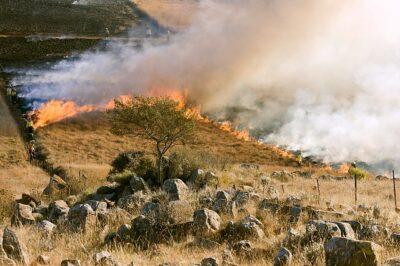There is nothing quite as powerful, dangerous and devastating as a wildfire. High temperatures, a lack of rain, and dry lightning storms have made this summer particularly bad for fires all across the country.
Despite fire being a difficult element to contain or control, there are ways homeowners can prevent or greatly reduce a wildfire from damaging their property and home. Here are eight tips to keep in mind.
1. Remove dead trees and branches
Dead, dying or damaged trees should be removed professionally or by yourself if you have the proper knowledge on felling trees. Keep in mind, however, that dead trees don’t “act” like a live tree and can be dangerous to take down. Dead branches also need to be removed.
2. Thin out woods and trim low-hanging tree branches
Many people neglect the care of their woodlots just because they don’t realize their woods and trees need to be taken care of just like their garden. Thankfully, trees don’t need anywhere near as much maintenance. For fire safety, you should adhere to the following guidelines for minimum spacing:
Discover More Than 1,000 Secrets For A Healthier, Safer Off-Grid Life!
- Six feet vertical clearance from ground to branches, or three times the height of any shrubs under tree (i.e. three feet of shrub means you’ll need nine feet of vertical clearance).
- Horizontal spacing up to mid slope (20 percent): 10 feet between trees, two times the height of shrub between shrubs.
- Horizontal spacing up to moderate slope (40 percent): 20 feet between trees, four times the height of shrub between shrubs.
- Horizontal spacing up to steep slope (40 percent+): 30 feet between trees, six times the height of shrub between shrubs.
3. Consider replacing your roof with metal
If you are building a house or have the money to replace your roof, do it. Many roofing materials, like shake or cheap shingles, will very easily catch sparks and light on fire. Instead, use metal roofing, slate or concrete tiles/shingles.
4. Keep your lawn short and well-watered
The lawn around your home should always be kept mowed to three inches or less and kept well-watered. Overgrown grass will more easily catch on fire and dry grass will act just like a tinder. If you don’t have the water available to keep your lawn lush, you may want to plant a grass lawn alternative.
5. Remove any dead vegetation, leaves and branches
All dead plants and fallen leaves need to be raked up and removed — preferably composted rather than burned. This is extremely important in the 30-foot zone around your house, but also extends to the rest of your property.
6. Use fire-resistant plants and materials for landscaping
Landscaping with only fire safety in mind is going to leave most people quite unhappy with a bare property. Therefore, when it comes to landscaping it is important to try and pick fire-resistant plants, especially for ornamental shrubs, small trees and other plants that may be very close to your house.
New Survival Energy Product Makes Every Window A Powerful Solar Charger
Most fire-resistant plants are drought-hardy and thrive in desert-type settings. But don’t just buy any plant. Ornamental grasses may do great in hot, dry weather, but they are not fire-resistant. Instead, look for succulent-type plants that stay fairly close to the ground and hold a lot of moisture in their leaves.
Additionally, try to substitute gravel and rock in your landscaping rather than mulch, wood chip and other such combustible materials.
7. Create 10 feet of safe space around any propane tank
It is recommended to keep propane tanks a minimum of 10 feet from the house with a minimum of 10 feet of safe space around them. This space can have short grass but using gravel/rock would be a better choice.
8. Ensure your address is visible and your property is easy to access
In the event of a house fire or a wildfire, it is important that firefighters can easily see your address, especially if you are in a rural area with a very long driveway. Your address sign should be large and bold. Your driveway should be at least 12 feet wide with an area large enough for a truck to turn around if it is longer than 150 feet
Remember: Firefighters’ first concern is to stay safe, and they won’t get themselves or their equipment into a situation that they won’t easily be able to get out of.
There are a few different programs available to help homeowners protect their land, all of which have their own specific toolkits and steps. If you live in a dry, hot region prone to wildfire damage or live a rural, wooded area, it would be a good idea to look into one of these programs.
Please share your tips as well as any personal stories of dealing with fires or wildfires in the comment section below.
Harness The Power Of Nature’s Most Remarkable Healer: Vinegar
 Off The Grid News Better Ideas For Off The Grid Living
Off The Grid News Better Ideas For Off The Grid Living





